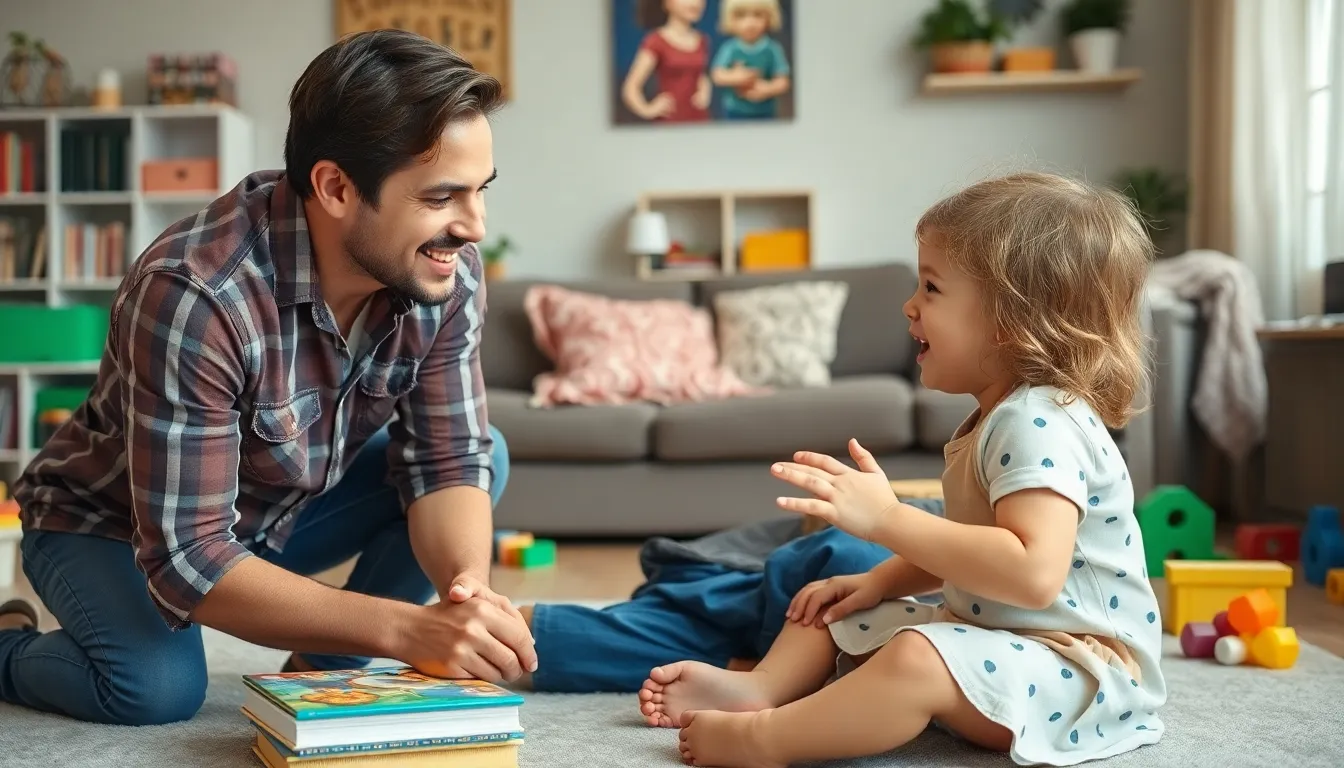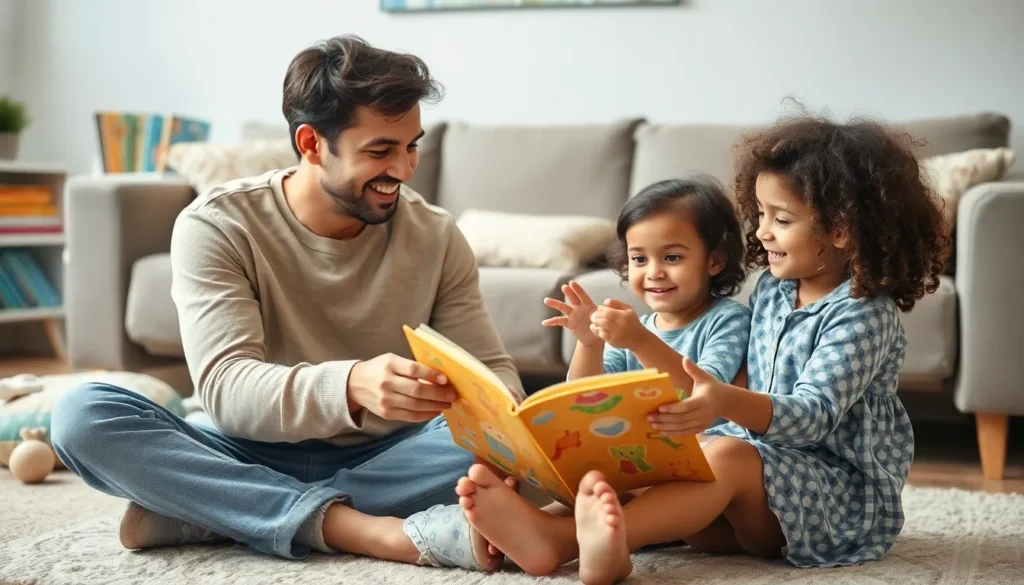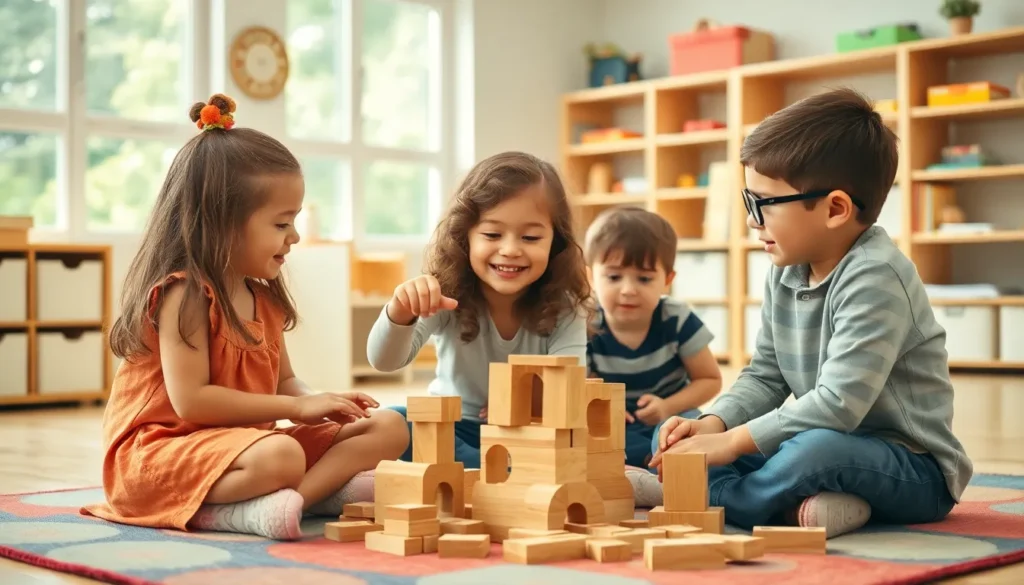Table of Contents
ToggleActive listening with kids isn’t just a skill; it’s an art form that can turn everyday conversations into magical moments. Imagine your child sharing their latest adventure with the enthusiasm of a superhero. If you’re busy scrolling through your phone or nodding absentmindedly, you might miss the chance to connect. Kids crave attention and validation, and mastering active listening can transform you from a mere audience member into their biggest fan.
Understanding Active Listening
Active listening involves fully concentrating on what children say, responding thoughtfully, and providing feedback. Engaging in this practice fosters stronger connections and enhances communication.
Definition of Active Listening
Active listening signifies more than just hearing words. It requires demonstrating genuine interest in a child’s thoughts and feelings. Techniques include maintaining eye contact, nodding in acknowledgment, and repeating back key points for clarity. By doing this, adults validate children’s experiences and create a supportive environment. This process invites children to express themselves freely, knowing they are valued and understood.
Importance in Child Development
Active listening plays a crucial role in children’s development. It supports emotional intelligence by teaching children how to express their feelings and navigate social interactions. Research indicates that children who experience active listening show improved communication skills as they grow. Additionally, these skills lead to enhanced self-esteem and greater confidence in sharing ideas. Providing a space for open dialogue encourages children to think critically and develop problem-solving abilities.
Techniques for Active Listening with Kids

Active listening techniques can significantly enrich conversations with children. Engaging in these methods fosters deeper connections and understanding.
Encouraging Open Communication
Creating a safe space for sharing enhances openness. Asking open-ended questions motivates kids to express their thoughts fully. Parents should validate feelings with supportive language, which encourages continued dialogue. When they show genuine interest, kids feel more comfortable discussing their emotions and experiences. Acknowledgment can be as simple as a nod or a verbal affirmation, reinforcing that their thoughts matter. Encouraging regular discussions aids in building a foundation of trust, making it easier for children to share their ideas in the future.
Reflective Listening Strategies
Using reflective listening can improve understanding during conversations. Paraphrasing what children say demonstrates active engagement and clarifies their thoughts. Parents should summarize key points to confirm understanding, which helps kids feel heard and valued. When adults ask thoughtful follow-up questions, it shows genuine interest in children’s responses. This method encourages kids to elaborate on their thoughts and feelings. Practicing reflective listening also enhances children’s speaking skills, as they learn to articulate their ideas clearly and confidently.
Benefits of Active Listening
Active listening brings numerous advantages when interacting with children. It fosters deeper connections and encourages open communication.
Strengthening Parent-Child Relationships
Active listening strengthens parent-child relationships by establishing trust. Children feel valued when adults remain attentive to their thoughts. Parents who engage with their kids during conversations build stronger emotional bonds. Such interactions encourage children to share experiences freely. Investments in active listening techniques lead to a more nurturing environment. Enhanced relationships promote healthier communication patterns as children learn to approach conversations with confidence and openness.
Enhancing Emotional Intelligence
Active listening significantly enhances children’s emotional intelligence. By validating feelings, adults help children recognize and express emotions. Children develop empathy through attentive dialogue, becoming more aware of others’ feelings. Active engagement in conversations fosters self-awareness and emotional regulation. When kids feel understood, they learn to manage their emotions more effectively. This process encourages critical thinking and problem-solving skills, essential for their overall development. Active listening nurtures emotionally intelligent individuals prepared to navigate complex social situations.
Challenges in Active Listening
Active listening with kids comes with unique challenges. Understanding these obstacles allows for more effective communication.
Common Barriers to Effective Listening
Distractions often hinder listening. Noise from other activities or electronic devices can break focus. Emotional states play a significant role as well; if a child feels upset or stressed, they may struggle to communicate clearly. Additionally, a lack of patience can limit a parent’s ability to listen effectively, leading them to interrupt or rush the conversation. Children may also use unclear language, making it difficult for adults to grasp their thoughts. Establishing a strong connection is essential for overcoming these barriers and enhancing engagement.
Strategies to Overcome Challenges
Creating a distraction-free environment fosters effective listening. Parents can set aside dedicated time for conversations and minimize interruptions. Practicing patience is crucial; allowing children to express their thoughts without interruption builds trust. Encouraging kids to use specific words helps clarify their ideas, while asking open-ended questions invites deeper conversation. Reflecting on what children say ensures they’re understood, which reinforces their confidence in sharing. Using these strategies can significantly enhance active listening, helping both adults and children engage more meaningfully.
Active listening is a transformative tool in nurturing relationships with children. By genuinely engaging with their thoughts and feelings, parents can foster a supportive environment that encourages open communication. This practice not only validates children’s experiences but also enhances their emotional intelligence and self-esteem.
Implementing active listening techniques can lead to deeper connections and healthier communication patterns. As parents become more attuned to their children’s needs, they empower them to express themselves confidently. The journey of active listening is ongoing and requires dedication, but the rewards of stronger bonds and enriched development are invaluable. Embracing this art form paves the way for a brighter future for both parents and children.






